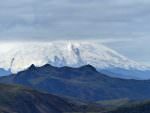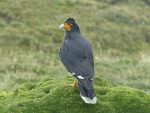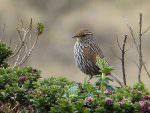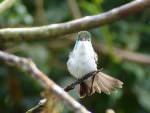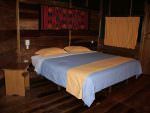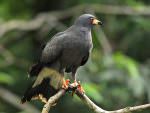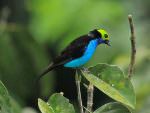Introduction
Ecuador is a birder’s paradise! From the misty cloud forests to the lush rainforests, the country is just full of stunningly beautiful, colourful and often rare species.
Antisana and Papallacta paramo high altitude grassland will offer several rare species from the magnificent Andean Condor high above to the small and dashing Ecuadorian Hillstar in the small patches of scrub habitat. Andean (Black-faced) Ibis are rare and can be found in this bleak landscape along with White-tailed Deer. Silvery Grebe, Andean Teal, Andean Duck and Yellow-billed Pintail are likely to be spotted on the lakes. For keen birdwatchers the ‘got to look for’ Rufous-bellied Seedsnipe is a must and your guide will know where to search for this too.
Striking Sword-billed Hummingbird, Green-fronted Lancebill & Gould’s Jewelfront will be targets on the East Slope along with the more sculking Plain-backed Antpitta and White-backed Fire-eye, plus so much more detailed in the itinerary.
Finish in the Amazon Rainforest and shock your senses – the odour of Red Howlers in the canopy and a species of Fishing Bat can be pretty pungent too, when they fly past as you journey the creeks in a dugout canoe. By the lake edges Snail Kites and Black-capped Donacobius sit on prominent perches, while Common Potoos try to disguise themselves as dead tree trunks. So much can be said about the birdlife in the canopy, easy to observe from high towers and the famous Sacha canopy walkway where iridescent Paradise Tanagers can divert your gaze from turquoise Spangled Cotingas and several species of raucous parrots.
There are many ways to extend this tour, so please contact us for details
Itinerary and price
Day 1: Flight to Quito to be organised by you
For help with your flight arrangements and to receive a no obligation quote, you can complete the enquiry form on our website or call 0800 280 8947 to speak to a flight advisor at StudentUniverse (in partnership with Gapyear.com), part of the Flight Centre Travel Group, a leading retailer of airfares and worldwide flights.
Meals: Payable directly today
There is a flight departing London Heathrow early morning which arrives in Quito in the evening. Some flights departing the UK earlier in the morning arrive in Quito late afternoon/evening.
Your driver will be outside Quito airport (look for your name on a placard) to welcome you and transfer you to Hotel Sebastian or similar. Relax for the remainder of the evening.
Note: Quito is located at high altitude in the Andes, almost 3,000 metres. To avoid any symptoms of altitude sickness and prepare for the following day we advise as early a night as possible with plenty of sleep AND avoid alcohol until you reach lower altitudes.
Day 2: Quito – Antisana – Papallacta and Guango Lodge
Meals: Breakfast, box lunch and dinner
For these next few days you'll be exploring the East slope of the Andes for birds and mammals with an experienced guide who knows East slope sites and habitats very well. We recommend breakfast at 0600 hours, then leave the hotel by 0630 hours with your guide. The drive to Antisana is approx. 1½ hours + stops as and when required on the journey to look for species which may include Giant Hummingbird and Aplomado Falcon. Other target species include Andean Condor, Andean (Black-faced) Ibis, Ecuadorian Hillstar, Carunculated Caracara, Silvery Grebe, Andean Ruddy Duck, Andean Teal, Andean Lapwing, Streak-backed Canastero, Chestnut-winged (Bar-winged) and Stout-billed Cinclodes. Sometimes Culpeo (Andean Fox) is seen here. The plan will be to spend the morning around Antisana and have lunch here.
From Antisana you'll head to Papallacta (another 1½ hour drive) and do some birding here, or at lower elevations if the altitude and weather conditions dictate. It will be another 45 minute drive to Guango Lodge, your base for two nights, and you should arrive around 1700 hours; dinner is usually at 1900 hours. At Papallacta there’s a chance to see both Mountain Tapir and Spectacled Bear, though both are extremely difficult, so having two visits may help with timings for birding and for mammals.
Day 3: Guango area (inc. time at Papallacta if required)
Meals: Breakfast, lunch or boxed lunch from Guango Lodge and dinner
We recommend breakfast at 0530 or 0600 hours. Based from Guango Lodge there will be plenty to look out for. Target species include Torrent Duck, Andean Guan, many hummingbirds including Sword-billed, Grey-breasted Mountain-Toucan, Dusky Piha, White-capped Dipper, Blue-backed Conebill, Buff-breasted Mountain-Tanager, Grey-hooded Bush-Tanager, Black-capped Hemispingus, Plushcap, (Northern) Mountain Cacique, Pale-naped and Slaty Brush-Finches.
If you didn’t find your targets at Papallacta, or are missing some key birds or mammals, then you could try again today. Targets in this area include Rufous-bellied Seedsnipe, Blue-mantled Thornbill, Viridian Metaltail, Andean Tit-Spinetail, Many-striped Canastero, White-chinned Thistletail, Tawny Antpitta, Red-crested Cotinga, Giant Conebill, Golden-crowned Tanager, Masked Mountain-Tanager, Black-chested mountain-Tanager and Black-backed Bush-Tanager. Mountain Tapir and Spectacled Bear occur, but are difficult to see. Night at Guango Lodge.
Day 4: Guango Lodge – San Isidro
Meals: Breakfast, lunch and dinner
Another early breakfast is suggested (0530 – 0600 hours) although the start time to San Isidro (approximately 1½ hours) can be a little flexible, depending on how the bird list is going. Target species for the San Isidro area include Black-and-chestnut Eagle, Wattled Guan, Black-banded (“San Isidro”) Owl, Rufous-banded Owl, another chance for Andean Potoo, Rufous-bellied Nighthawk, Oilbird, Crested and Golden-headed Quetzal, Masked Trogon, Andean (Highland) Motmot, Crimson-mantled Woodpecker, Powerful Woodpecker, Streak-headed (Long-tailed) Antbird, Chestnut-crowned Antpitta, White-bellied Antpitta, Slate-crowned Antpitta, Rufous-crowned Tody-Flycatcher, Barred Becard, Black-billed Peppershrike, Chestnut-breasted Chlorophonia, Flame-faced Tanager, White-capped Tanager and Subtropical Cacique. Mammals to look out for include Black Agouti, possibly Mountain Tapir, Kinkajou and the very rare Giant Anteater. Night at San Isidro Lodge. Note: at night you have a chance of seeing the San Isidro Owl, which is a high elevation form of Black-banded Owl and possibly a new species or subspecies. They often sit in the lodge grounds and are normally fairly easy to find.
Day 5: San Isidro area
Meals: Breakfast, lunch and dinner
We recommend a 0530 – 0600 breakfast before birding around the lodge looking for several different species that feed on the moths attracted to the lights. At 0700 hours we hope to see both White-bellied and Chestnut-crowned Antpitta that often come to feed on worms. Use today wisely searching for any missing target species along local trails, where hopefully you will see Andean Potoo, but if not, you might give it another try at dusk at a nearby locality. Also check early morning or late afternoon for Black Agouti. Spend another night at San Isidro Lodge.
Day 6: San Isidro – Guacamayos - Wildsumaco
Meals: Breakfast, box lunch and dinner
Again after a recommended 0530 – 0600 hours breakfast, check out of San Isidro Lodge and journey to Wildsumaco. Just a 30 minute drive from San Isidro is Guacamayos where target species include White-throated Screech-Owl, Swallow-tailed Nightjar, Black-billed Mountain-Toucan, Streaked Tuftedcheek, Flammulated Treehunter, Strong-billed Woodcreeper, Greater Scythebill (very rare), Barred Antthrush, Ocellated Tapaculo, Handsome Flycatcher, Rufous-headed Pygmy-Tyrant, Slaty-backed Chat-Tyrant, Green-and-black Fruiteater, Black-chested Fruiteater, Golden-eyed Flowerpiercer, Chestnut-bellied Thrush, Vermilion Tanager, Blue-browed Tanager, Rufous-crested Tanager and Grass-green Tanager. Lunch can be wherever you please but most likely will be at Guacamayos. In the afternoon do some roadside birding on the way to Wildsumaco Lodge, your base for four nights. Expect to arrive by 1700 hours, have dinner around 1830 hours and relax for the rest of the evening.
Day 7: Wildsumaco area
Breakfast, lunch and dinner
Breakfast at 0530- 0600 is recommended. Yet again you'll have a great time exploring another ecologically diverse area for birds and mammals. Today you will bird the Antpitta trail in the morning where two species are possible, Plain-backed and Ochre-breasted. In the afternoon, time spent around the lodge and checking hummingbird feeders would be well worthwhile. After dinner at 1830 take time to specifically look for mammals and owls on a night walk from Wildsumaco, actively searching with a high-powered torch; there's a chance of Margay, Opossums, Kinkajou and Night monkey. Target species at Wildsumaco include Black Hawk-Eagle, several species of Forest-Falcons, Rufous-breasted Wood-Quail, Blackish Rail, Scaled Pigeon, Military Macaw, Spot-winged Parrotlet, Vermiculated (Foothill) Screech-Owl, Rufescent Screech-Owl, Band-bellied Owl, many hummingbirds (too many to mention), Coppery-chested Jacamar, Chestnut-tipped Toucanet, Golden-collared Toucanet, Black-mandibled Toucan, Black-streaked Puffbird, Rufous-breasted and Lafresnaye’s Piculet, Crimson-bellied Woodpecker, Black-billed Treehunter, Red-billed Scythebill, Lined Antshrike, White-streaked Antvireo, Russet Antshrike, Foothill Antwren, Plain-winged Antwren, Yellow-breasted Antwren, Blackish Antbird, White-backed Fire-eye, Short-tailed Antthrush, Plain-backed Antpitta, Ochre-breasted Antpitta, Chestnut-crowned Gnateater, a lot of flycatchers (too many to list but including Yellow-throated Spadebill), Scarlet-breasted and Fiery-throated Fruiteater, Gray-tailed Piha, Rufous-naped Greenlet, Gray-mantled Wren, Musician Wren, Wing-banded Wren, Golden-collared Honeycreeper, Blue-naped Chlorophonia, Bronze-green Euphonia, Orange-eared Tanager, Golden-eared Tanager, Paradise Tanager, Fulvous Shrike-Tanager, Olive Finch, Blue-rumped and White-crowned Manakin. Nights at Wildsumaco Lodge.
Day 8: Wildsumaco area
Meals: Breakfast, lunch and dinner
Expect breakfast around the same time. In the morning explore the F.A.C.E. trail and in the afternoon venture out along the Benavides Trail with dinner around 1830 hours. Night at Wildsumaco Lodge, with opportunities to search for mammals.
Day 9: Wildsumaco area
Meals: Breakfast, lunch and dinner
Another early start and then off to explore the Piha trail in the morning and in the afternoon explore the best bits of roadside habitat to pick up some new species. Expect dinner around the same time. Night at Wildsumaco Lodge, with opportunities to search for mammals. Note: You’ll say goodbye to your guide this evening.
Day 10: Wildsumaco – Coca – Sacha
Meals: Breakfast at Wildsumaco, packed lunch provided by Sacha Lodge at La Mision and dinner at Sacha Lodge
You may have a little time before breakfast to explore locally around the lodge (without guide today). Then you will leave Wildsummaco Lodge for the 2 hour drive to Coca to arrive at La Mision Port in Coca at 1100 hours without fail. Other Sacha guests arriving in Coca on a flight from Quito will arrive at La Mision Port and from here you’ll meet your Sacha Lodge representative who will guide you to where you’ll board a high-powered motorised canoe and your journey along the Napo River will begin, followed by a short stroll along a boardwalk then the final part of the journey by dugout canoe. If you are lucky Red Howler Monkey, Great or Common Potoo and Hoatzin may put in an appearance before you reach Sacha Lodge! Your luggage will arrive as if by magic at the lodge and staff will explain the plan for the next few days, you'll check-in to your cabins and meet your guide for a late afternoon journey by dugout canoe along some of the Amazonian channels.
Days 11, 12 and 13: Sacha area
Meals: Breakfast, lunch and dinner
The wildlife around Sacha is extremely diverse and experienced guides will help point out many characteristic species of the area. Over these days explore trails on foot, channels by dugout canoe, birdwatch from the top of a canopy tower and walk through the tree tops along the impressive canopy walkway. We are likely to see Many-banded Aracari, Spangled Cotingas, Blue-and-Yellow Macaw, Golden-collared Toucanet, Green-and-Gold and Opal-rumped Tanagers at eye level from the canopy walk way and towers. On forest walks mammals may include Squirrel Monkey, Pygmy Marmoset, White-fronted Capuchin and Night Monkey. Nights at Sacha Lodge. At some point during these three days you will visit the parrot clay licks at Yasuni National Park where you will need to pay the entrance fee of approx. $22 per person directly.
Day 14: Sacha – Coca – Quito
Meals: Breakfast
Today you journey back to Coca and Quito from Sacha Lodge (time and flight details to be supplied), returning the way you arrived via the channels, boardwalk, Napo River and a flight departing Coca for Quito.
Tours ends.
Note: You can if you wish extend your experience in the Amazon rainforest with a stay at Napo Wildlife Centre. Please enquire and we can supply a supplement.
Extra note: If you require an extra night in Quito to link with your international flight please enquire and we can provide a supplement.
Price per person valid from 1 January to 31 December 2019:
Based on two travelling on a twin share basis: US $ 4765
Based on three travelling on a twin share basis: US $ 4185
Based on four travelling on a twin share basis: US $ 3895
Single supplement US $ 545
Price includes:
Accommodation as specified
All land transfers
Meals as mentioned above
All entrance fees to sanctuaries for the whole tour (except Yasuni in the Amazon which is payable directly)
Bird checklist, pre-travel and top tips for travel advice
Services of an experienced guide on an exclusive basis for the East slope
Transfer to Coca town on Day 10 with a driver only
And for the Amazon…
All land/boat transfers
Experienced bilingual naturalist guide at Sacha Lodge and a native guide (max. group size is usually 6 at Sacha)
Price excludes:
International flight
Internal flight from Coca – Quito (approx. US $120 per person)
Yasuni entrance fee when you visit the parrot clay licks (approx. US $22 per person)
Travel insurance
All drinks. You may need to purchase the odd teas/coffees/beer every now and again at establishments with excellent veranda/restaurant bird feeding stations. Filtered water in the Amazon is usually available, but bottled water would need to be purchased
Tips
Phone calls, laundry and anything else of personal nature







